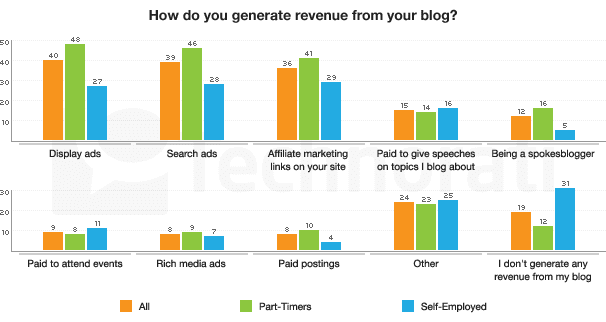Are Brands moving in the blogosphere?
This would be consistent with the growing influence of bloggers and brands trend to move towards Social Marketing. We sometimes forget, that blogs, despite their disseminate nature, are one of the most dynamic social media tools.
This would be consistent with the growing influence of bloggers and brands trend to move towards Social Marketing. We sometimes forget, that blogs, despite their disseminate nature, are one of the most dynamic social media tools.
Gary Hayes' Social Media Counts , that displays in real time the evolution of social medias, indicates, for example, that in one minute, 630 new posts are published on blogs for 2806 new tweets, equaling a ratio of 1 to 4.5.
A very positive ratio for blogs, given that posts are much denser than tweets.
Technorati, the famous blog search engine, annually publishes a State of the Blogoshpere, which also analyzes blogs economic activity.
Marketing executives admit more and more that bloggers post high quality content and attract growing and loyal audiences.
The 2008 study already suggested that a strong percentage of bloggers monetize their sites in different ways:
Average revenue generated by blogs was $6000, with 1% of blogs yielding sales of more than $200,000!
The 2009 study, just published by Technorati, indicates that a large majority of bloggers monetize their sites or would like to.
Nevertheless a variety of ways characterizes the monetization of blogs:
Advertising is not the only path offered to bloggers. As leaders of opinion the influence acknowledged by bloggers is highlighted in the graph below:
This reality can only precede a strengthened investment of brands in regards to blogs.
Even more so, given that posts often mention brand names. 70% of bloggers confirm that they talk about brands.
Technorati, classifying bloggers into several categories (hobbyist, part-timers, self-employed and corporate workers), reveals the following motives:
Ratios and cases already analyzed for Twitter emphasize how important it is that brands consider the influence of blogs. Among those bloggers that mention brands or products in their posts, 47% do so on a monthly basis.
It is in this context that the F.T.C. (Federal Trade Commission), responsible for protecting the American consumers, decided that bloggers, starting on December 4th, should disclose all advertising revenue or sales generated by their blogs.
However, will this apparently positive decision for a greater transparency, be applicable ?
The obligation to disclose all “material connections” between brands and blogs, which is not forced upon traditional media, also risks affecting the press copies for writing reviews.
Facing much protest, which was touched upon this weekend by L. Gordon Crovitz, the influential columnist of The Wall Street Journal, there is a possibility that the FTC is backtracking, at least in part.
Since the FTC decision is likely to include tweets or updates on Facebook, Gordon Crovitz questions,
“There are also practical objections. For example, if you get a free copy of a book and then post a comment about it on Twitter, how many of the permitted 140 characters must be dedicated to the disclosure? Do employees of a company have to disclose the fact of their employment every time they comment on its products through their personal Facebook accounts?”
In wanting to over regulate Social Commerce, will governments become anti-social?


















